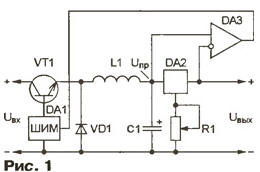Once the author of this article took quite a powerful and reliable source power adjustable within wide limits output voltage. After researching literature, he came to the conclusion that proposed for repeating devices have weaknesses: linear stabilizers large size (due to the need the use of oxide of big capacitors and heatsinks), PWM stabilizers fairly narrow range of regulation and the output voltage there are high frequency ripple, and the devices with improved consumer qualities (current limited, display modes, switching of the windings transformer, etc.) is relatively complex. I had to look for other solutions, and in the result was developed by the power source is free from these disadvantages.
The proposed laboratory power source applied a two-stage converting the rectified voltage: PWM conversion to intermediate stress and subsequent linear stabilization. Main technical features are as follows: the limits of regulation of the output voltage - from 1.3 to 30 V, the factor of instability in the voltage - 0,07%/ the instability of the current load of 0.1%, maximum input (AC) voltage - 27, conversion efficiency at maximum load current is not less than 70 %. You can change the threshold current up to 1.2 A, there netrogena the short circuit protection with led indication. The source is characterized by small size, minimal heat loss (at a current load up to 0.3 And the heat sinks are not required).
Block diagram of the device shown in Fig. 1.

Input voltage UBX transforms the PWM Converter DA1 in the intermediate Unp, which, in its turn, is input to the analog stabilizer DA2. Feedback through the differential amplifier DA3 supports necessary for DA2 fall voltage (for LM317 - 2.5), so that the heat loss for DA2 minimum.
Schematic diagram of the power source shown in Fig. 2.

Rectified the voltage output from the bridge VD1 is smoothed by the capacitor C1 and applied to the input of the PWM Converter, harvested from element DA1, VT2, VD2, L1. The switching circuit DA1 - model reduction [1]. The use of chip CREW minimized the number of passive elements, but put a limit on the maximum input the tension that such inclusion should not exceed 40 V. the PWM with cumulative inductor L1 and the diode VD2 generates an intermediate voltage at Ypres the capacitor C4.
On integrated circuit stabilizer DA2 assembled linear voltage regulator. Control variable resistor R12. Diodes VD3 and VD4 protect the chip from reverse currents and negative voltages and entered in accordance with the recommendations on its application [2].
Oh DA3 and resistors R7-R10 form a differential amplifier that monitors the voltage drop across the regulator DA2. The gain DA3 is chosen to be equal 1.5, which allows you to maintain a set value in the interval voltages and currents, including for short-circuited output. Trimmer resistor R2 regulate the voltage drop at the establishment.
The elements VT1, HL1, R1 made the motion detector of a short-circuited state output. In normal operation, the transistor VT1 is open, and the voltage drop is does not exceed a few tenths of a volt. When the voltage at the output source to 0.7 V or less, the transistor VT1 is closed and the led starts HL1 to glow. Engaged state of the power source is indicated by an led HL2.
Very interesting is the role of the resistor R5. When the voltage across it is more than 120 mV (average the value defined empirically) effective internal the pulse-width limiter circuits DA1, turning it into a current source. This property CREW you can use to limit the maximum current load. For example, when the resistance of this resistor, 0.1 Ohm, the source is capable of delivering to the load current up to 1.2 A, and when R5 = 1 Ω only to 120 mA. By installing a resistor the resistance of 0.5 Ohm and thereby limiting the current load value 240 mA, you can opt out of the heat sink for the chip and DA2 from external current key PWM Converter (excluding the transistor VT2, a resistor R3 and a connecting pin 2 DA1 to a connection point of the inductor L1 and the diode VD2). In this case, the size of the product will be not much bigger than a matchbox.
As the key VT2 can use any transistor with a static the current transfer ratio base to more than 30 and the allowable current collector is not less than 3 A. the Author used CHAM. He has a good frequency properties, so small switching loss. Very well 'behaves' in this place field MOSFET IRF3205 - he doesn't need a heat sink at currents up to 1 And the Inductance the inductor L1 can be anywhere from 40 to 600 µh, the only requirement is that he must be a current capacity of at least 1.5 A. Resistors MLT, C1-4 permitted the resistance deviation from nominal ±10 %, trimmer resistor R2 - multi-turn wire SP5-VB or similar, R12 AC - any type resistance 4,7 6,8...com. Capacitors C1 and C4 - oxide C50-35 capacity 220...470 µf rated voltage 63 V, the remaining ceramic (CH2, K10-7, K10-it. p.).
The establishment of the power source is to install a trimming resistor R2 voltage 2.5 V between pins 2 and 3 DA2 (at 50% load).
Literature
Author: S. Murali, Dimitrovgrad, Ulyanovsk region






